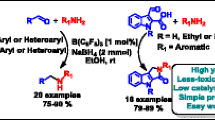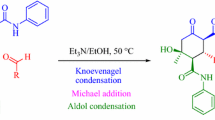Abstract
A facile and highly convenient base-free protocol for the chemoselective preparation of 1,2-diol mono-esters is described. In this method, the regioselective ring opening of epoxides with carboxylic acids in the presence of [bmim]Br furnishes the corresponding 1,2-diol mono-esters in excellent yields. This method is efficient for various structurally diverse epoxides and carboxylic acids and it can be efficiently applied for the scale up synthesis of 1,2-diol mono-esters in reasonable to good yields. [bmim]Br remarkably influences the reaction progress and acts as both solvent and catalyst in this protocol.
Similar content being viewed by others
References
Wasserscheid P, Welton T (2003) Ionic liquids in synthesis. Wiley, Weinheim
Welton T (1999) Room-temperature ionic liquids. Solvents for synthesis and catalysis. Chem Rev 99: 2071–2084. doi:10.1021/cr980032t
Gu DG, Ji SJ, Jiang ZQ, Zhou MF, Loh TP (2005) An efficient synthesis of bis(indolyl)methanes catalyzed by recycled acidic ionic liquid. Synlett (6)959-962 doi:10.1055/s-2005-865194
Xue H, Verma R, Shreeve JM (2006) Review of ionic liquids with fluorine-containing anions. J Fluorine Chem 127: 159–176. doi:10.1016/j.jfluchem.2005.11.007
Hajipour AR, Rafiee F (2009) Basic ionic liquids. A short review. J Iran Chem Soc 6: 647–678
Bao W, Wang Z (2006) An effective synthesis of bromoesters from aromatic aldehydes using tribromide ionic liquid based on L-prolinol as reagent and reaction medium under mild conditions. Green Chem 8: 1028–1033. doi:10.1039/B604096A
Chowdhury S, Mohan RS, Scott JL (2007) Reactivity of ionic liquids. Tetrahedron 63: 2363–2389. doi:10.1016/j.tet.2006.11.001
Zhao D, Wu M, Kou Y, Min E (2002) Ionic liquids: applications in catalysis. Catal Today 74: 157–189. doi:10.1016/S0920-5861(01)00541-7
Dupont J, de Souza RF, Suarez PAZ (2002) Ionic liquid (molten salt) phase organometallic catalysis. Chem Rev 102: 3667–3692. doi:10.1021/cr010338r
Qiao K, Yakoyama C (2004) Novel acidic ionic liquids catalytic systems for Friedel-Crafts alkylation of aromatic compounds with alkenes. Chem Lett 33: 472–473. doi:10.1246/cl.2004.472
Sun W, Xia CG, Wang HW (2003) Synthesis of aziridines from imines and ethyl diazoacetate in room temperature ionic liquids. Tetrahedron Lett 44: 2409–2411
Kamal A, Chouhan G (2005) A task-specific ionic liquid [bmim]SCN for the conversion of alkyl halides to alkyl thiocyanates at room temperature. Tetrahedron Lett 46: 1489–1491. doi:10.1016/j.tetlet.2005.01.040
Earle MJ, Ktdare SP, Seddon KR (2004) Paradigm confirmed: the first use of ionic liquids to dramatically influence the outcome of chemical reactions. Org Lett 6: 707–710. doi:10.1021/ol036310e
Parker RE, Isaacs NS (1959) Mechanisms of epoxide reactions. Chem Rev 59: 737–799. doi:10.1021/cr50028a006
Movassaghi M, Jacobsen EN (2002) A direct method for the conversion of terminal epoxides into γ-butanolides. J Am Chem Soc 124: 2456–2457. doi:10.1021/ja025604c
Taylor SK (2000) Reactions of epoxides with ester, ketone and amide enolates. Tetrahedron 56: 1149–1163. doi:10.1016/S0040-4020(99)01074-1
Bonini C, Righi G (1994) Regio- and chemoselective synthesis of halohydrins by cleavage of oxiranes with metal halides. Synthesis (3):225–238. doi:10.1055/s-1994-25445
Reddy JM, Jocobson EN (2002) A practical oligomeric [(salen)Co] catalyst for asymmetric epoxide ring-opening reactions. Angew Chem Int Ed 41: 1374–1377. doi:10.1002/1521-3773(20020415)41:8$<$1378::AID-ANIE1378$>$3.0.CO;2-L
Armstrong RN, Cassidy CS (2000) New structural and chemical insight into the catalytic mechanism of epoxide hydrolases. Drug Metabol Rev 32: 327–338. doi:10.1081/DMR-100102337
Guengerich FP, Johnson WW (1999) Kinetics of hydrolysis and reaction of aflatoxin B1 exo-8,9-epoxide and relevance to toxicity and detoxication. Drug Metabol Rev 31: 141–158. doi:10.1081/DMR-100101911
Nurbaş M, Asadov ZH, Aga-Zade A D, Kabasakal S, Ahmadova GA, Zenouzi MB (2005) Surfactants based on higher carboxylic acids and epoxy compounds. Iran Polym J 14: 317–322
Posner GH, Rogers DZ (1977) Organic reactions at alumina surfaces. Mild and selective opening of arene and related oxides by weak oxygen and nitrogen nucleophiles. J Am Chem Soc 99: 8214–8218. doi:10.1021/ja00467a015
Posner GH (1978) Organic reactions at alumina surfaces. Angew Chem Int Ed Engl 17: 487–496. doi:10.1002/anie.197804871
Iranpoor N, Tarrian T, Movahedi Z (1996) FeCl3.6H2O Supported on SiO2 catalysed ring opening of epoxides with alcohols, acetic acid, water, chloride, bromide and nitrate ions. Synthesis (12):1473–1476. doi:10.1055/s-1996-4416
Iranpoor N, Shakarrize M, Shiriny F (1998) Highly efficient, regio- and stereoselective ring opening of epoxides and thiiranes with Ce(OTf)4. Synth Commun 28: 347–366. doi:10.1080/00397919808005728
Carron M, Sharpless KB (1985) Nucleophilic opening of 2,3-epoxy acids and amides mediated by titanium isopropoxide. Highly enhanced C-3 selectivity. J Org Chem 50: 1560–1563. doi:10.1021/jo00209a048
Jacobsen EN, Kakiuchi F, Kensler RJ, Larrow J, Tokunaga M (1997) Enantioselective catalytic ring opening of epoxides with carboxylic acids. Tetrahedron Lett 38: 773–776. doi:10.1016/S0040-4039(96)02414-8
Iranpoor N, Firouzabadi H, Safavi A, Shekarriz M (2002) Ring opening of epoxides with carboxylates and phenoxides in micellar media catalyzed with Ce(OTf)4. Synth Commun 32: 2287–2293. doi:10.1081/SCC-120005998
Apparo S, Schmidt RR (1987) Synthesis of functionally substituted α,β-unsaturated carbonyl compounds. Synthesis (10):896–899. doi:10.1055/s-1987-28113
Shevchenko VV, Pashinnik VE, Batog OP, Bondarenko PA (2004) Photoinitiated reaction of carboxylic acids with oxiranes. Russ J Org Chem 40: 278–279
Moghadam M, Mohammadpoor-Baltork I, Tangestaninejad S, Mirkhani V, Shariati L, Babaghanbari M, Zarea M (2009) Zirconyl triflate, [ZrO(OTf)2], as a new and highly efficient catalyst for ring-opening of epoxides. J Iran Chem Soc 6: 789–799
Betti C, Landini D, Maia A (2006) Metal ion electrophilic catalysis’ in ring-opening reactions of 1,2-epoxides by metal halides in ionic liquids. Synlett (9):1335–1338. doi:10.1055/s-2006-941562
Horváth A, Frigyes D, Mahó S, Berente Z, Kollár L, Skoda-Földes R (2009) Synthesis of steroidal vicinal hydroxysulfides via the reaction of steroidal epoxides with thiols in the presence of an ionic liquid. Synthesis (23):4037–4041. doi:10.1055/s-0029-1217031
Kantam ML, Chakravarti R, Sreedhar B, Bhargava S (2008) Friedel-Crafts alkylation of nitrogen heterocycles using [bmim][OTf] as a catalyst and reaction medium. Synlett (10):1449–1454. doi:10.1055/s-2008-1078423
Chen J, Wu H, Jin C, Zhang X, Xie Y, Su W (2006) Highly regioselective ring-opening of epoxides with thiophenols in ionic liquids without the use of any catalyst. Green Chem 8: 330–332. doi:10.1039/B600620E
Yoshino H, Nomura K, Matsubara S, Oshima K, Matsumoto K, Hagiwara R, Ito Y (2004) A mild ring opening fluorination of epoxide with ionic liquid 1-ethyl-3-methylimidazorium oligo hydrogenfluoride (EMIMF(HF)2.3). J Fluorine Chem 125: 1127–1129. doi:10.1016/j.jfluchem.2004.02.002
Yadav JS, Reddy BVS, Basak AK, Venkat Narsaiah A (2003) [Bmim]BF4 Ionic liquid: a novel reaction medium for the synthesis of β-amino alcohols. Tetrahedron Lett 44: 1047–1050. doi:10.1016/S0040-4039(02)02735-1
Xu LW, Li L, Xia CG, Zhao PQ (2004) Efficient synthesis of chlorohydrins: ionic liquid promoted ring-opening reaction of epoxides and TMSCl. Tetrahedron Lett 45: 2435–2438. doi:10.1016/j.tetlet.2004.01.042
Yadav JS, Reddy BVS, Jyothirmai B, Murty MSR (2005) Ionic liquids/H2O systems for the reaction of epoxides with NaN3: a new protocol for the synthesis of 2-azidoalcohols. Tetrahedron Lett 46: 6559–6562. doi:10.1016/j.tetlet.2005.07.074
Yang MH, Yan GB, Zheng YF (2008) Regioselective ring-opening reactions of 1,2-epoxides with thiols and arylselenols directly promoted by [Bmim]BF4. Tetrahedron Lett 49: 6471–6474. doi:10.1016/j.tetlet.2008.08.109
Cohen T, Dughi M, Nataro VA, Pinkus G (1962) The direction of opening of styrene oxide by acetic acid. J Org Chem 27: 814–819. doi:10.1021/jo01050a030
Hirano M, Morimoto T (1984) Oxidation by cobalt(III) acetate. Part 6. A novel synthesis of the glycol monoacetates from aromatic olefins in wet acetic acid. J Chem Soc Perkin Trans 2: 1033–1036. doi:10.1039/P29840001033
Greene TW, Wuts PGM (1999) Protective groups in organic synthesis. Wiley, New York
Khalafi-Nezhad A, Soltani Rad MN, Khoshnood A (2003) An efficient method for the chemoselective preparation of benzoylated 1,2-diols from epoxides. Synthesis (16):2552–2558. doi:10.1055/s-2003-42416
Dupont J, Consorti CS, Suarez PAZ, de Souza RF (2002) Preparation of 1-butyl-3-methyl imidazolium-based room temperature ionic liquids. Org Synth 79: 236–240
Creary X, Willis ED (2005) Preparation of 1-butyl-3-methylimidazolium tetrafluoroborate. Org Synth 82: 166–169
Santry L J, Azer S, McClelland RA (1988) Alkyl group effects on the rate constants and equilibrium constants for formation of cyclic tetrahedral intermediates. J Am Chem Soc 110: 2909–2914. doi:10.1021/ja00217a036
McClelland RA, Seaman NE, Cramm D (1984) Observation of a stable hemi ortho ester anion. Acidity constant for a tetrahedral intermediate. J Am Chem Soc 106: 4511–4515. doi:10.1021/ja00328a034
Safavi A, Abdollahi H, Maleki N, Zeinali S (2009) Investigation of the role of ionic liquids in tuning the pK a values of some anionic indicators. J Sol Chem 38: 753–761. doi:10.1007/s10953-009-9407-2
Murugesan S, Wiencek JM, Ren RX, Linhardt RJ (2006) Benzoate-based room temperature ionic liquids-thermal properties and glycosaminoglycan dissolution. Carbohydr Polym 63: 268–271. doi:10.1016/j.carbpol.2005.09.022
Peng Y, Li G, Li J, Yu S (2009) Convenient synthesis of various ionic liquids from onium hydroxides and ammonium salts. Tetrahedron Lett 50: 4286–4288. doi:10.1016/j.tetlet.2009.05.015
Shyamala Devi V, Maji S, Viswanathan KS (2011) Novel room temperature ionic liquid for fluorescence enhancement of Eu3+ and Tb3+. J Lumin 131: 739–748. doi:10.1016/j.jlumin.2010.11.029
Author information
Authors and Affiliations
Corresponding author
Electronic Supplementary Material
The Below is the Electronic Supplementary Material.
Rights and permissions
About this article
Cite this article
Rad, M.N.S., Behrouz, S. The base-free chemoselective ring opening of epoxides with carboxylic acids using [bmim]Br: a rapid entry into 1,2-diol mono-esters synthesis. Mol Divers 17, 9–18 (2013). https://doi.org/10.1007/s11030-012-9412-z
Received:
Accepted:
Published:
Issue Date:
DOI: https://doi.org/10.1007/s11030-012-9412-z




